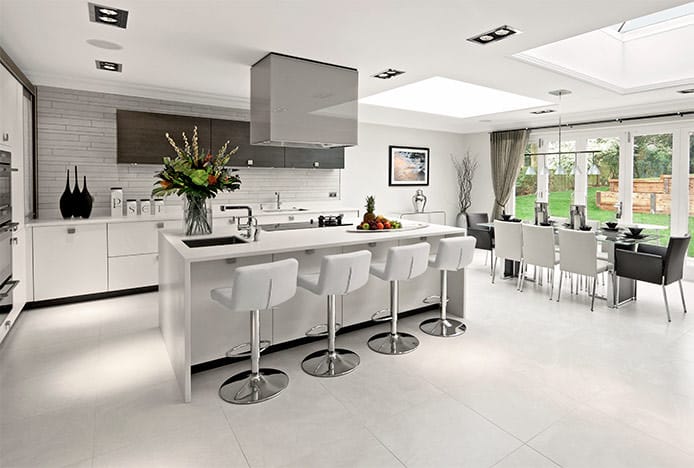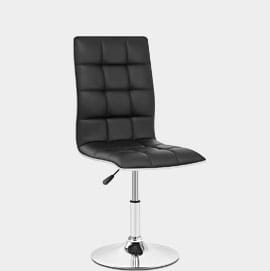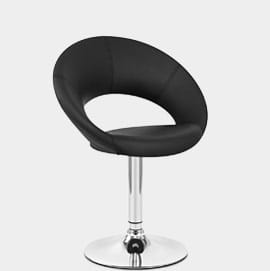Difference Between Bar Stools and Chairs
By Adrian Higgins, 28th January, 2013
Whilst there are many similarities between bar stools and chairs, their contrasting purposes define key differences in their design. From where they’re used and what they’re used for, to the way we sit on them and the extra features that enhance usage, there are more variables than you think. This guide will talk you through the key differences, helping you decide on the ideal product for you.

Contrasting Seat Heights
An obvious dissimilarity is their difference in height due to the varying locations they’re intended to be used in. Meant for use at a table – whether in the kitchen, restaurant, home office or beyond - the majority of chairs are fixed at standard dining table height. Dining tables generally measure around 75cm from the ground, and therefore we recommend you choose seating somewhere in the 43-48cm range for a comfortable fit.
Conversely, bar stools are designed for use in a variety of environments, from nightclubs to beauty salons, to medical practices. Commercial bars are fairly high at 105cm and above, and therefore when used in these settings we’d advise a stool height of 75-80cm. Alternatively, stools can also be used in the home at the kitchen worktop and breakfast bar. Kitchen worktops measure approximately 90cm, and so for domestic use we’d suggest a seat height of around 65-70cm. For your convenience, our collection of kitchen stools have been handpicked for this setting.
Need further guidance? More detailed advice can be found on our bar stool buying guide page.

Variation in Backrest Height
From three course dinner parties to homework sessions at the kitchen table, we're often sat on chairs for longer lengths of time than bar stools. What’s more we sit on them in a different way, and hence our posture has helped to influence their design. As the tendency is to lean back and relax into a chair, they require a higher backrest for optimum support. Additionally, they typically have more padding and upholstery to ensure a comfortable seating experience when sitting for extended periods. The Carlo is a classic example of this, with a regal elevated backrest with scroll top that offers quality comfort as well as a sophisticated elegance.
In contrast, a large backrest is not needed with bar stools as the inclination is to lean forward and rest our elbows on the bar. Nevertheless many customers appreciate a backrest, as seen in the Drift, or a minimalist low lip like on the Lulu for that extra feeling of security.
There is also an aesthetic reason for bar stools not having backrests that are too large, as if they had a high back like a chair they’d look very out of place. Not only would they take up more room, but they’d be visually crowding and you wouldn’t be able to see over them to the bar or worktop area. Instead, stools are often more compact in size, shape and style, which suits their purpose beautifully. Yet it’s worth noting that whilst chairs are generally bigger, they do provide a wider variety of stackable designs for neat and tidy storage.

Additional Stool Features
Whilst the majority of chairs are fairly standard in what they offer, bar stools come with an impressive range of added extras for state-of-the-art functionality to meet their differing purpose. First of all, a footrest is included to provide a supportive perch for the feet. This feature is not needed with chairs where your feet can reach the floor.
Central column framed stools will largely possess a gas lift mechanism for adjustable height, allowing each user to achieve the ideal seating position, whatever their size. Included with this is 360 degree swivel, making the seat easily accessible when getting on and off. Instead of having to move the entire stool away from the bar, which can be difficult if it’s heavy, its enhanced mobility means you can simply swivel round without disturbing those around you.
Combined Designs
Whilst there is a market for people who want a bar stool and chair in one, this can prove more restrictive due to the variation in height. The main problem lies with the footrest, as when you lower the stool to table height, the footrest will hit the base and won’t let you descend as low as needed. Nevertheless, we have developed two solutions to help you get round this. Firstly we offer a range of bar stools without or with very minimal footrests, enabling you to lower them to table height.
Exceedingly popular due to their compact aesthetic, here are three of the best:
Our second solution takes the form of our collection of dining chairs with 360 swivel and adjustable height, providing the best of both a stool and chair in one stylish design. These are brilliant if you have varying surface heights, for example if your table is higher than the norm or you own a customised bar area, and you're struggling to find a standard fixed height seat to fit. Alternatively, if you have a breakfast bar and a dining table in your kitchen, and want matching seating at the two, these adaptable seats can be used at both for a harmonious and uniform aesthetic. Great versatile designs for multi-purpose use, they could be used at worktop height day-to-day then turned into additional table seating for special occasions and dinner parties with extra guests, or simply whenever the need arises.
Here are three of our bestselling chairs with stool functionality:
Like what you see? Why not take a look at our expansive collection of dining chairs, where you’re sure to find what you’re looking for. Or, to shop our stylish collection of bar stools just click the button below.
Related Articles
Eames Kitchen & Dining Chairs
Discover the iconic chair designs of the legendary Charles and Ray Eames..
Unique Dining Chairs
Stand out from the crowd with our range of exclusive chair designs..
Designer Kitchen Chairs
Discover exclusive designs and iconic replica classics for every kitchen..
Different Styles of Dining Chairs
From funky to classic, take a look at four different dining chair styles..




















 Style
Style High Back
High Back Christiana
Christiana Macy
Macy Clementine
Clementine Rochelle
Rochelle